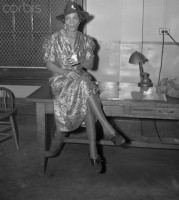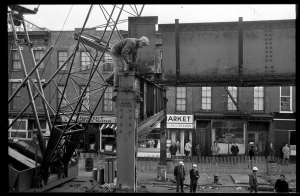
Stephanie St. Clair Hamid held on charges of using her estranged husband for a target. (Photo by Bettman/Corbis)
In The Court of the Crime Queen of Harlem
by Sumi Naidoo
Three shots rang out in the third floor hall of 309 West 125th St in Harlem, less than a block down from the newly reopened Apollo Theater. It was 3:10 p.m. on Tuesday, January 18, 1938. Outside, the .38 revolver’s booming report most likely lost itself in the chatter of the bustling crowds and the metallic rattle of the Kingsbridge, Broadway and Tenth Avenue streetcars that ran up and down 125th Street, carrying passengers from Manhattan to the Bronx and back. No one who had been outside the office block admitted to hearing the gun go off — not the first, second or third time. But inside, the noise ricocheted off walls and slithered down staircases, looking for a willing host. It found two. Read More…
Leaker, Traitor, Whistleblower, Spy?
by Ian Macdougall
Drew Pearson drove to the Pentagon with an ambush in mind. It was 1957, around the ides of March—a fitting time for an ambush—and his car wended its way through a capital city brightened by spring’s recent arrival. On the National Mall, hints of narcissus displaced brittle winter air. Soon, the edge of the Tidal Basin would dissolve into clouds of pink and white cherry blossoms. But Washington’s buoyant sense of spring deflated on Pearson’s windshield as he drove from the yellow brick townhouse in Georgetown where he lived and worked, crossed the Potomac River into Virginia, and headed south, toward the vast five-sided bunker where defense officials had sequestered what was rightfully his. Read More…
The Yezidi Massacre
by John Ismay
With four massive truck bombs, Al-Qaeda tried to finish the Yezidis once and for all.
The Yezidis, long a persecuted minority in Kurdish Iraq and Turkey, have endured millennia of attacks, massacres, and exclusion from the people living around them, but all of that paled in comparison to what happened to the villages of Jazeera and Kahtaniya on August 7, 2007.
On that day, two towns were murdered. And the world paid little attention. Read More …
Empires Will Fall
by Nicholas Lehr
On the evening of Saturday, March 6, 1954, New York’s media and political elite converged in the Grand Ballroom of Times Square’s luxurious Astor Hotel for the Inner Circle’s annual roast. The Inner Circle, a parody group comprised of the state’s veteran political reporters, had titled this year’s lampoon “Junior Frolics,” the name of a popular children’s television program — and a pointed jab at the two “Juniors” considered rising stars within the Democratic party: newly-minted New York City Mayor Robert F. Wagner, Jr. — the son of former New York Senator Robert F. Wagner — and Congressman Franklin D. Roosevelt, Jr., who represented Manhattan’s West Side and was now running for governor. Read More…
Rabbit Hole
by Andrew Lenoir
Welcome to Brooklyn, or at least the underside of it. You’re under Borough Hall, base of operations for Brookyln’s Borough government, current president Marty Markowitz. Take the stairs to your right, up to Court Street. That’s better. The building beside you— federal style, temple-fronted, cupola topped with a golden statue? It had another name once, City Hall, which is fitting. Brooklyn was its own city up until 1898, and this served as the heart of operations. City Hall started getting built around 1846, and it’s one of the oldest landmarks in the area. Let’s turn to the east, to an even older landmark, its buried twin. Read More…

Myrtle Ave El being dismantled in the neighborhood of Clinton Hill, Brooklyn, in 1969. (Courtesy of William Gedney Photographs and Writings, David M. Rubenstein Rare Book & Manuscript Library)
Dividing Brooklyn
by Annel Hernandez
On October 4, 1969, just a few minutes after midnight, the last train departed from the Jay Street station, filled to capacity with eager riders. Theresa King was only one of thousands of people who flocked to the Myrtle Avenue El for one last ride. It was a celebratory goodbye party for the outdated train that carried so many people to work, to school, and to other endless destinations for 80 years. Read More…